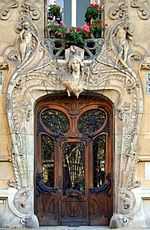Jules Lavirotte
Jules Aimé Lavirotte (Lyon, March 25, 1864 - Paris, March 1, 1929) was a French architect who designed no fewer than nine buildings still standing in the 7th arrondissement of Paris, or in immediately surrounding arrondissements. His flamboyant work won him acclaim among his contemporaries, and won him the Concours de Façades de la Ville de Paris on at least two occasions: once for the building at 29 Avenue Rapp (1901), and again for the Ceramic Hotel, 34 Avenue de Wagram (1904).
Early life
Lavirotte was born in Lyon, and went on to study at the Ecole des Beaux-Arts in Lyon, where he was a pupil of Antoine Georges Louvier (1818–92). He subsequently studied at the Ecole des Beaux-Arts in Paris under the tutelage of Paul Blondel (1847–97), and gained his architect's diploma there in 1894.[1]
Buildings
- 151 Rue de Grenelle, 7th arrondissement (1898)
- 12 Rue Sedillot, 7th arrondissement (1899)
- 3 Square Rapp, 7th arrondissement (1899)
- 134 Rue de Grenelle, 7th arrondissement (1900)
- 29 Avenue Rapp, 7th arrondissement (1901)
- Chateau at Chaouat (Tunisia, c.1904)
- Villa at Chaouat (Tunisia, c.1904)
- Restoration of the Church at Chaouat (Tunisia, c.1904)
- Ceramic hotel, 34 Avenue de Wagram, 8th arrondissement (1904)
- 169 Boulevard Lefebvre, 15th arrondissement (1906)
- 23 Avenue de Messine, 8th arrondissement (1906, top floors added later, doing away with Lavirotte’s garden roof)
- 6 Rue de Messine, 8th arrondissement (1907)
- 2 Rue Balzac, Franconville, Val d’Oise (c.1907)
151 Rue de Grenelle, 7th arrondissement (1898)
The first major building designed by Lavirotte. Its facade—influenced by the French Rococo style—offers only hints of the theatrical displays for which Lavirotte was to become known.
12 Rue Sedillot, 7th arrondissement (1899)
The earliest Lavirotte building to feature an unconventional assembly of whimsical themes and oddities.
29 Avenue Rapp, 7th arrondissement (1901)

The large scale deployment of glazed earthenware on the facade of this building is the first example of its kind in the West.[2] Glazed tiles embedded in the stone and in the bricks are the work of ceramicist Alexandre Bigot; the building proved to be an effective advertisement for his wares.[3] It was very lavishly adorned even by the standards of the many ceramically finished facades that were built in the following years, which were for the most part appointed this way because this was a way to protect and beautify the iron and concrete materials whose use was fast becoming the standard. The building at 29 avenue Rapp also had a highly exotic door frame designed by the sculptor Jean-Baptiste Larrive, and sculpted by Messrs Sporrer, Firmin-Marcelin Michelet, and Alfred Jean Halou.[4]
Notes
- ↑ Franco Borsi and Ezio Godoli: Paris 1900, page 213-226, 278 (1978, Granada Publishing Ltd., St Albans and London)
- ↑ Maurice Rheims: The Age of Art Nouveau, page 32 (1966, Thames and Hudson, London)
- ↑ The Grove Dictionary of Art (1996, ISBN 1-884446-00-0)
- ↑ Maurice Rheims: The Age of Art Nouveau, page 32 (1966, Thames and Hudson, London)
| Wikimedia Commons has media related to Jules Lavirotte. |
Roy Johnston: Parisian Architecture of the Belle Epoque (2007, ISBN 978-0-470-01555-1)
External links
- Beautiful pictures of Jules Lavirotte Art Nouveau Buildings in Paris
- Pictures and description of many Lavirotte buildings around Paris
- http://www.paris1900.blogspot.com/search/label/Lavirotte
- Jules Lavirotte - current photographs
|